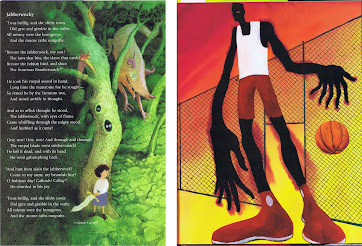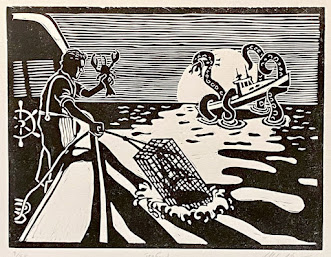Lewis Carroll’s famous poem Jabberwocky, a classic of nonsense fantasy, has been wildly popular since its publication in 1871. (If you’re not familiar with it, you can read the whole poem in two of the pictures below, or more easily in my original post about it here.) Since its publication, there have been many illustrations of the jabberwock and the other creatures featured in the poem. By far the most iconic is the version by John Tenniel, the first picture shown here. Indeed, it remains my favorite to this day. But Carroll doesn’t actually say much about exactly what these creatures look like, and that means that other illustrators can come up with completely different versions. Paired with Tenniel’s illustration is a tile by William De Morgan, who was commissioned by Dodgson (aka Carroll) to make tiles with creatures related to his works. That means that Tenniel’s and De Morgan’s jabberwocks, different as they are, were both Lewis Carroll-approved.
So, we know the jabberwock has jaws that bite, claws that catch, and eyes of flame. We know it’s manxome, and that it whiffles and burbles… And that’s really all we know. So there’s no contradiction if Kevin Hawkes depicts the jabberwock rather like a pig, while Christopher Myers connects the poem with the Mesoamerican ball game and depicts the jabberwock like a monstrous basketball player.
Joel Stewart can follow Tenniel’s lead in giving the jabberwock a few items of gent’s clothing, while adding a checkerboard grin and long, stripy tail. And Eric Copeland can imagine something more like a feathered dragon. No wrong answers here, as long as we all have those grabby claws! Scary or whimsical? Similar to a real creature, or completely wacky? It’s all fair.
Some illustrators have also shown us some of the other creatures mentioned in the poem. Tenniel depicted the toves, borogoves, and raths of the first verse, which you can see here. But he never showed the jubjub bird or bandersnatch, which perhaps left the door open a little wider for the illustrators who followed. Peter Newell makes his magnificent jabberwock a little reminiscent of a naked mole-rat, while his bandersnatch looks somewhat baboon-inspired, and the jubjub bird is simply a bit odd.
Charles Santore gives each of these charismatic megafauna a full double-page spread. His jabberwock is clearly a dragon, and his jubjub bird would indeed be something to beware, but his bandersnatch is the most original, resembling a tiger-warthog cross with a spiked tail
For a few more versions of the Jubjub bird you can revisit my posts on Mythical J, and be sure to see my own depiction at J is for Jubjub Bird. (I’ve never done the jabberwock because I’m completely satisfied that Tenniel got it right.)
I conclude with one last artist, Mark V. Marshall, who worked at Doulton Pottery. I’ve included his jabberwock sculpture for completion, although it doesn’t particularly excite me, but I find his rath absolutely delightful. I’m assuming it’s some kind of little pitcher. All we know about the raths from the poem is that they’re mome. Humpty Dumpty tells Alice that raths are a sort of green pig, which has clearly inspired Marshall.
What’s your vision of the jabberwock? Does it wear clothes? Is it a dragon or a mole-rat or a basketball player? Or do you have some completely new ideas of your own?
[Pictures: Jabberwock, pen and ink (copied as wood engravings for printing), by Sir John Tenniel, 1871;
Jabberwock (and Jubjub bird?), illustration by Kevin Hawkes from Imagine That! Poems of Never-Was selected by Prelutsky, 1998;
Jabberwock, illustration by Christopher Myers from Jabberwocky, 2007;
Jabberwock, illustration by Joel Stewart from Jabberwocky, 2003;
Jabberwocky, illustration by Eric Copeland from Poetry for Young People: Lewis Carroll, ed. E. Mendelson, 2000;
Jabberwock, Jubjub bird, and Bandersnatch, illustrations by Peter Newell from Through the Looking-Glass, 1902 (Images from Internet Archive);
Jabberwock, Jubjub bird, and Bandersnatch, illustrations by Charles Santore from Jabberwocky, 2020;
Jabberwock and rath, Doulton pottery by Mark V. Marshall, c. 1886 (Images from Wiener Museum of Decorative Arts).]






















